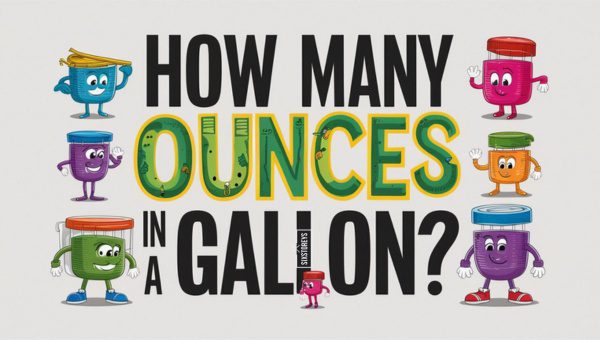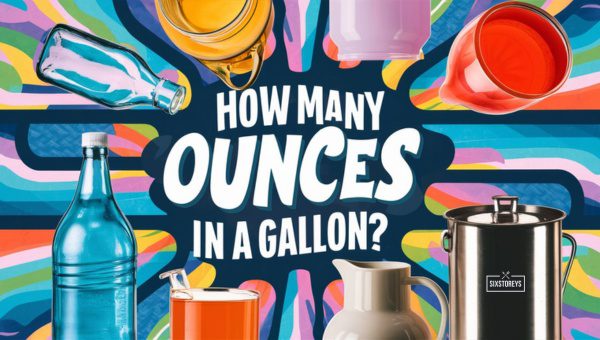How many Ounces in a Gallon? Find Out Now
I find myself constantly navigating the maze of measurements in the kitchen and beyond, whether it’s for a fun baking session or just getting through everyday chores. We live in a world where measurements matter—whether it's water for a recipe, milk for that creamy sauce, oil for frying, honey for your tea, or even ice cream for dessert. That’s why understanding conversions can make life so much easier.
Just the other day, I stumbled upon a question that seems deceptively simple but is equally essential: how many ounces in a gallon? This seemingly small piece of knowledge can have a big impact. Imagine whipping up a batch of homemade ice cream and not having the right measurements—it could end in disaster! So, join me as we delve into the world of gallons and ounces, making those culinary adventures and daily tasks a breeze.

Also Read: How Many Ounces are in a Cup?
Article Includes
Why Knowing Conversions Is Important?
Have you ever found yourself in the middle of a recipe only to realize you need to convert measurements? It happens to me all the time. Knowing conversions isn’t just handy; it can be a game-changer. Imagine making a large batch of your favorite homemade soup. You need to know exactly how much water to add. Or perhaps you're indulging in some weekend baking, and the recipe calls for a gallon of milk or oil. You’d need the right amount for the perfect texture and taste. Let’s not forget our sweet honey, which is often used in smaller quantities but still needs precise measurement. And for all the ice cream aficionados out there, accurate measurements ensure your creamy treat turns out just right.
Conversions aren't just for cooking, either. They come in handy while filling up your car with gas, especially if you're traveling internationally. Different countries use different measurement systems, and that's where knowing your conversions can save you from a lot of hassle. It's like having a universal translator for measurements in your back pocket.
How many Ounces in a Gallon?
Let's cut to the chase. When someone asks, “How many ounces in a gallon?” the straightforward answer is 128 ounces in a U.S. gallon. There you have it! This conversion might seem trivial, but it’s crucial, especially when dealing with larger quantities.
Breaking It Down into Smaller Quantities
To make it even simpler, here’s a quick rundown:
- 1 gallon = 128 ounces
- 1/2 gallon = 64 ounces
- 1/4 gallon = 32 ounces
Comparison with the Imperial Gallon
Now, if you’re on the other side of the pond, the measurements differ slightly. An Imperial gallon, used in the UK, is equivalent to 160 ounces. Here’s a handy table to make the comparison clear:
| Measurement | U.S. Gallon (Ounces) | Imperial Gallon (Ounces) |
|---|---|---|
| 1 Gallon | 128 | 160 |
| 1/2 Gallon | 64 | 80 |
| 1/4 Gallon | 32 | 40 |
Knowing these conversions helps me feel more confident whether I'm in the kitchen, at the gas station, or just dealing with everyday measurements. It’s all about making life a little easier.
Breaking It Down: U.S. Gallon vs. Imperial Gallon
When I first delved into the world of liquid measurements, I found it intriguing—and a tad confusing—that not all gallons are created equal. The United States and some other countries use the U.S. gallon, while the United Kingdom and a few others stick to the Imperial gallon. So, what's the difference?
U.S. Gallon
A U.S. gallon is defined as 128 fluid ounces. This is the standard measurement you'll encounter when you buy milk, water, or even gasoline in the United States. It's also the measurement we'd typically use for recipes and various household tasks.
Imperial Gallon
On the other hand, the Imperial gallon is a bit larger, clocking in at 160 fluid ounces. That's right—if you're in the UK, your gallon of milk or water will actually give you more liquid. This difference is pretty substantial and can throw off recipes and other tasks if you're not careful.
Here's a quick comparison to make it clear:
| Measurement | U.S. Gallon | Imperial Gallon |
|---|---|---|
| Fluid Ounces | 128 oz | 160 oz |
Understanding this difference is especially crucial if you're following a recipe from a different country or if you're traveling. It saves you from making common kitchen blunders and ensures accuracy in your measurements.
The History Behind Gallon Measurements

Ever wonder why we have different types of gallons? The history behind these measurements is both fascinating and pivotal in understanding the larger picture of global standards.
Origins
The term gallon has its roots in Latin, where galleta or galleon meant a container. Over time, various cultures adopted and adapted the gallon measurement to fit their needs. In medieval England, different commodities like ale and wine had their own gallons. Eventually, the British standardized it with the Imperial system in 1824.
Standardization
In the United States, however, the adoption of the gallon was influenced by the British wine gallon, leading to the U.S. gallon we use today. This divergence from the Imperial gallon happened to facilitate trade and commerce, reflecting the distinct developmental paths both nations took.
Why Do We Use Gallons and Ounces?
Ever paused to consider why we stick with gallons and ounces for measuring liquids like water, milk, oil, honey, and even ice cream? Here’s why these units have stood the test of time.
Practicality
One of the main reasons gallons and ounces continue to be widely used is their practicality. Both units provide a flexible range for measuring large and small quantities. For instance:
- Gallons are perfect for larger volumes like tanks of fuel or big containers of milk.
- Ounces are ideal for precision, whether you're measuring oil for a recipe or honey for your tea.
Widespread Use
In the United States, gallons and ounces are deeply ingrained in everyday life. They are standard units in recipes, fuel consumption, and even in medical and scientific measurements. The ease of these units comes from their widespread usage, making it simpler for everyone to understand and communicate quantities effectively.
Familiarity
There's also a certain comfort in familiarity. Over years and generations, people have grown accustomed to these measurements. Switching to an entirely new system would require a massive cultural shift that, frankly, most of us aren't ready for.
Understanding why we use gallons and ounces helps us grasp their ubiquity and why they are likely here to stay. Whether you’re whipping up a dish in the kitchen, filling up your car’s gas tank, or buying a jug of milk, these measurements are our reliable companions in everyday activities.
Common Scenarios: When You'll Need This Conversion
Every now and then, I find myself in situations where knowing the exact measurement conversions makes life a whole lot easier. Here are some common scenarios where understanding how many ounces are in a gallon can really come in handy:
Cooking and Baking
Cooking and baking are the obvious culprits where liquid measurements become crucial. Whether it's making a large pot of homemade soup or preparing a batch of cookies, knowing that there are 128 ounces in a gallon can save you from potential mishaps. Imagine needing to measure out gallons of water or milk for a recipe but only having a smaller measuring cup marked in ounces. It can quickly turn into a guessing game if you don't know the conversion.
Meal Prepping
If you're into meal prepping, you’ve likely faced the daunting task of measuring large quantities of liquids ranging from soup to sauces. Having a clear understanding of the conversion can streamline the process. For example, if your meal prep calls for a gallon of broth, you now know to measure out 128 ounces without second-guessing.
Gardening
In the garden, fertilization and watering often require precise measurements. Many liquid fertilizers come with instructions in gallons, but your watering can might only have ounce markings. Knowing the conversion helps ensure your plants get just the right amount of nutrients and water.
DIY Projects
When tackling DIY projects around the house, from DIY cleaners to homebrewed solutions, you might need specific amounts of substances. Imagine creating a gallon of homemade eco-friendly cleaner. Being confident that you’re mixing 128 ounces can make your DIY endeavors both safer and more effective.
Health and Fitness
For those who are into health and fitness, particularly athletes who meticulously track their water intake, knowing how many ounces are in a gallon helps in meeting daily hydration goals. For instance, if your aim is to drink a gallon of water a day, it’s handy to know that translates to 128 ounces.
Also Read: How Many Ounces of Water Should I Drink Daily?
Frequently Asked Questions
How Many Ounces Are in a Half-Gallon?
A half-gallon is exactly half of a gallon—no surprises there! So, in terms of ounces, a half-gallon equals 64 ounces. This is incredibly useful to know, particularly if you’re halving a recipe or measuring smaller amounts for health reasons.
Do These Conversions Apply Internationally?
This is where things get a bit tricky. The U.S. gallon and the Imperial gallon differ. While a U.S. gallon equals 128 ounces, an Imperial gallon equals 160 ounces. So, if you’re following a recipe or instructions from another country, it’s crucial to know which gallon measurement is being referenced.
How Many Ounces Are in a Quart?
Understanding this secondary measurement helps make conversions easier. There are 32 ounces in a quart. Since there are 4 quarts in a gallon, you’ll see how everything ties together in a straightforward manner—128 ounces in a gallon.
How Many Ounces Are in a Gallon of Ice Cream?
Ice cream often comes in different container sizes, and if you're buying in bulk, it's handy to know there are 128 ounces in a gallon of ice cream. Now you can easily calculate or divide portions for a party or store leftovers more efficiently.
Can I Use a Standard Measuring Cup for Gallon Measurements?
A standard measuring cup, typically measuring up to 8 ounces, can be used, but it requires some math. For instance, you’d need 16 of these cups to make up a gallon. While not impossible, having this knowledge simplifies the task.
Conclusion
Understanding how many ounces are in a gallon simplifies so many aspects of our daily routines. Whether you're measuring water for a science project, portioning out milk for a morning smoothie, gauging oil for a weekend frying endeavor, drizzling honey into your nightly tea, or scooping out ice cream for a summer treat, this knowledge is incredibly useful. I've found that having a firm grasp on these conversions brings a sense of ease and confidence to my kitchen projects and beyond. Feel free to share your own experiences or any additional questions in the comments below—I’d love to hear how you’re putting this newfound knowledge to good use!
